 Heat Illness Prevention
Heat Illness Prevention 
Shade and Other Cooling Measures Elements of Your Written Program and Effective Work Practices
What is in T8CCR 3395?
T8CCR 3395(b) Definitions state:
- "Shade" means blockage of direct sunlight. One indicator that blockage is sufficient is when objects do not cast a shadow in the area of blocked sunlight. Shade is not adequate when heat in the area of shade defeats the purpose of shade, which is to allow the body to cool. For example, a car sitting in the sun does not provide acceptable shade to a person inside it, unless the car is running with air conditioning. Shade may be provided by any natural or artificial means that does not expose employees to unsafe or unhealthy conditions and that does not deter or discourage access or use.
T8CCR 3395(d) Access to shade states:
- (1) Shade shall be present when the temperature exceeds 80 degrees Fahrenheit. When the outdoor temperature in the work area exceeds 80 degrees Fahrenheit, the employer shall have and maintain one or more areas with shade at all times while employees are present that are either open to the air or provided with ventilation or cooling. The amount of shade present shall be at least enough to accommodate the number of employees on recovery or rest periods, so that they can sit in a normal posture fully in the shade without having to be in physical contact with each other. The shade shall be located as close as practicable to the areas where employees are working. Subject to the same specifications, the amount of shade present during meal periods shall be at least enough to accommodate the number of employees on the meal period who remain onsite.
- (2) Shade shall be available when the temperature does not exceed 80 degrees Fahrenheit. When the outdoor temperature in the work area does not exceed 80 degrees Fahrenheit employers shall either provide shade as per subsection (d)(1) or provide timely access to shade upon an employee's request.
- (3) Employees shall be allowed and encouraged to take a preventative cool- down rest in the shade when they feel the need to do so to protect themselves from overheating. Such access to shade shall be permitted at all times. An individual employee who takes a preventative cool-down rest (A) shall be monitored and asked if he or she is experiencing symptoms of heat illness; (B) shall be encouraged to remain in the shade; and (C) shall not be ordered back to work until any signs or symptoms of heat illness have abated, but in no event less than 5 minutes in addition to the time needed to access the shade.
- (4) If an employee exhibits signs or reports symptoms of heat illness while taking a preventative cool-down rest or during a preventative cool-down rest period, the employer shall provide appropriate first aid or emergency response according to subsection (f) of this section.
Exceptions to subsections (d)(1) and (d)(2):
- (1) Where the employer can demonstrate that it is infeasible or unsafe to have a shade structure, or otherwise to have shade present on a continuous basis, the employer may utilize alternative procedures for providing access to shade if the alternative procedures provide equivalent protection.
- (2) Except for employers in the agricultural industry, cooling measures other than shade (e.g., use of misting machines) may be provided in lieu of shade if the employer can demonstrate that these measures are at least as effective as shade in allowing employees to cool.
T8CCR 3395 (i)(1) states the following:
- (i) Heat Illness Prevention Plan. The employer's shall establish, implement, and maintain, an effective heat illness prevention plan. The plan shall be in writing in both English and the language understood by the majority of the employees and shall be made available at the worksite to employees and to representatives of the Division upon request. The Heat Illness Prevention Plan may be included as part of the employer's Illness and Injury Prevention Program required by section 3203, and shall, at a minimum, contain:
- (1) Procedures for the provision of water and access to shade.
Guidance, Best Practices and Warnings
To prevent heat illness, there must be a balance between heat load on the body (heat produced internally by the body and gained from external sources) and heat released from the body to allow the body to cool.
When to Provide Shade?
Cal/OSHA requires that when temperature in the workplace exceeds 80 degrees, shade structures must be erected if no other shade is readily available.
Even if temperatures do not exceed 80 degrees, shade must still be available, and it is helpful to have the shade erected if the weather is hot enough that the shade can help employees cool off.
Employers should monitor predicted weather temperatures in advance (for example, by television or radio or on the Internet) to know when the temperature will probably exceed 80 degrees. Employers are expected to know if the temperature is in fact exceeding 80 degrees at the worksite.
Amount of Shade
"Recovery and rest period" refers to the normal breaks. Employers are required to provide enough shade to accommodate all of the employees who are on such a break at any point in time. This does not mean that employers are required to provide enough shade to accommodate all of the employees on the shift at the same time. Employers may, for example, rotate the breaks among employees. They may also erect additional structures on an as-needed basis.
During meal periods, the employer must provide enough shade for all of the employees who choose to remain in the general area of work or in areas designated for recovery and rest periods. Employers may rotate employees in and out of meal periods, like with recovery and rest periods. Employers are not required to provide shade for employees who choose to spend meal periods in their own air-conditioned vehicles. However, employers may not require or pressure employees to eat their lunch in their own vehicles or go off site to eat.
Ways To Provide Cooling
You need to provide shade as required to employees to allow their bodies to cool during breaks (see Benefits of Rest Breaks), at lunch, or during a preventative cool down rest periods (see Preventative Cool Down Rest Periods) should one become necessary. Except for employers in Agriculture, you can use one or more Alternative Cooling Measures (in lieu of shade) to provide cooling to your employees, see Shade and Other Cooling Measures. To use these Alternative Cooling Measures you must make sure they are safe to use for the conditions in your workplace and demonstrate that they are at least as effective as shade in allowing employees to cool. Also, during high heat you may need to add one or more Alternative Cooling Measures to prevent heat illness.
No matter how you choose to provide cooling for your employees remember to ensure that:- Sufficient supplies of potable drinking water are close by
- Individuals are encouraged to frequently drink sufficient amounts of water
- Employees are able to assume comfortable body postures
Best Practices
Ways to Provide Shade
You can provide cooling from shade by using:
- Pop-ups
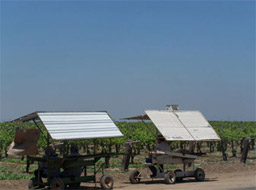
- Canopies
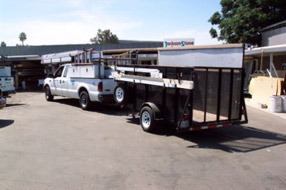
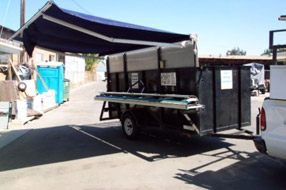
- Umbrellas
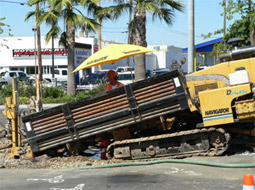
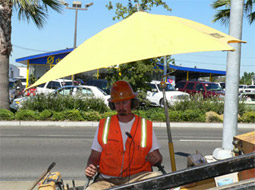
- Structures that are mechanically ventilated or open to air movement (e.g., semi finished garages or other unfinished structures). If two or more stories are available employees can rest in the lowest floor in the shade.
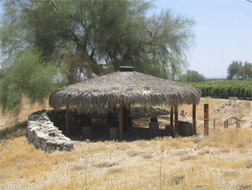
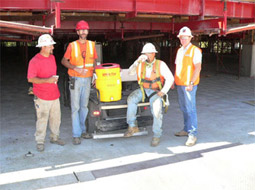
- Tarpaulins tied to 4 posts
- Lean-tos
- Conex mounted RV canopies
- Full and thick tree canopies that block direct sunlight
- Buildings
- Enclosed areas only if they provide cooling comparable to shade in the open air
Providing Cooling from Shade
- It is a good idea to set up the shade in advance, if at 5:00 p.m. the night before, the temperature is predicted to exceed 80° F. Or if you want to monitor the temperature during the work hours, perform hourly checks of the temperature at the worksite on the day of work and set up the shade immediately if the temperatures exceeds 80 Degrees.
- Set-up shades such that there will always be room for employees wanting to have rest under the shade and for handling emergency situations during warm or hot weather, high heat and a heat wave.
- Set-up in advance portable umbrellas, canopies, and other portable devices used for providing shade
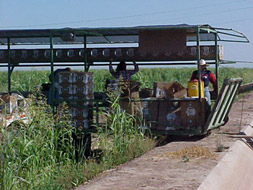
- Move portable shade areas as close to work areas as possible.
- In situations where trees or other vegetation are used to provide shade, have a designated person evaluate the thickness and shape of the shaded area before assuming that sufficient shadow is being cast to protect employees throughout the shift.
- Have a designated person to point out the daily location of the shade structures to the workers.
- Do not let employees sit directly on the ground as it may add more heat to the body. Instead, provide blankets, chairs, benches, etc.
- 2 weeks in advance (or as many days in advance as possible), go on the internet (www.noaa.gov), call the National Weather Service or check the Weather Channel TV to view the extended weather forecast in order to plan in advance the work schedule. Find out whether high heat is expected and if additional work schedule modifications will be necessary. This type of advance planning should take place all summer long.
- Prior to each workday, have a designated person monitor the weather using
www.noaa.gov or a thermometer at the
worksite see Monitor The Weather. Based on the weather, make modifications to
the work schedule such as stopping work early, rescheduling the job, working at
night or during the cooler hours of the day, and increasing the number of water
and rest breaks. The designated person can check the temperature every 60
minutes to ensure that once the temperature:
- exceeds 80 degrees Fahrenheit, the shade structures are accessible to the workers.
- indicates an upcoming heat wave, special precautions are taken.
- equals or exceeds 95 degrees Fahrenheit High Heat Procedures are implemented.
Best Practices
Other Cooling Measures
For non-agricultural employers, when it is not possible to erect a shade structure, the employer may use alternative procedures for providing access to shade. Before using alternative cooling measures make sure they are safe to use for the conditions in your workplace and you must demonstrate that they are at least as effective as shade in allowing employees to cool.
Alternative cooling measures include, but are not limited to, cooling employees by:
- Putting them in an air-conditioned environment, if available
- Using misting machines
- Using cooling vests (e.g., commercially available ice vests)
- Using water-cooled garments (e.g., hoods, vests and "long johns"). These require a battery-driven circulating pump, liquid-ice coolant, and a container
- Using battery operated, portable cooling devices or equipment
- Using air cooled garments (e.g., suits or hoods)

